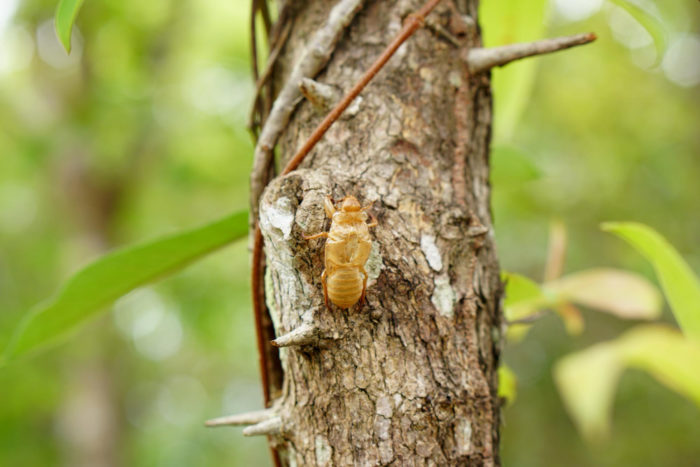Summer brings along with it ice cream trucks and lemonade stalls but most importantly, it brings the song of cicadas. Ever wondered why cicadas only play their song once a year or, in some regions, once in a blue moon?
Widely regarded as the epitome of a carefree lifestyle and immortality, cicadas are indeed a magnificent breed of insects.
These beautiful buggers lead an out-of-the-ordinary life and, depending on the species, emerge after 17 years of being underground. So, let’s take a look at the life cycle of cicadas to know more about their behavior.
Life Cycle of a Cicada
There are mainly three stages that a cicada goes through during its entire life cycle. These are namely, egg, nymph, and adult stage.
Stage 1: Egg
The life cycle of a cicada begins when a male and female cicada mate.
After mating, the female cicada moves to tender young branches to lay eggs. The females deposit these eggs in groups on twigs near the end of branches. This process is carried out in more than 200 kinds of trees.

One female cicada can lay 200 to 400 eggs in tiny holes that they make in the branches of trees and shrubs. While the mere presence of adult cicadas poses no threat to humans, the egg-laying behavior of females can damage trees, especially young ones whose canopies comprise many tender young shoots.
Stage 2: Nymph
The tree branches provide the egg with shelter and nutrients. The eggs hatch in about six weeks. Thus begins the nymph stage in the life of the cicada. These nymphs instantly fall to the ground.
Within minutes of reaching the surface, these nymphs dig burrows and find roots on which they can feed. The young nymphs usually feed on small roots such as grass. As they grow bigger, they start feeding on nutrients and drinking xylem from tree roots.
The low nutrient content of xylem fluid may help explain in part the very long period of juvenile development of cicada nymphs. The nymphs stay underground for a long period which varies from species to species.
Now, there are more than 3,000 known species of cicadas worldwide. Out of these myriads of bugs, the annual cicadas, known as dog-day cicadas in the U.S., are found throughout the world. Whereas, the periodical cicadas that emerge after a long haul of 13 to 17 years are predominantly found in North America.
Stage 3: Adult
The final stage of the life cycle begins after the nymphs come out from the ground. Cicada nymphs sometimes create turrets or chimneys above the tunnel hole from where they eventually appear.
Cicadas seem to build chimneys in wetter, muddier areas. These chimneys help keep water and mud from back-filling their holes, so they can continue to breathe, take a peek out and prepare to emerge.
Nymphs find the nearest surface to climb on, which are usually trees. The cicada nymphs then molt their shell and leave their exoskeleton behind. An exoskeleton is a hard outer covering that helps support and protect the bug.
After the wings appear, the transformation is complete. The adult cicada now gets ready to mate. A week after they emerge, the male cicadas sing to attract the females. A swarm of male cicadas will gather in a tree to give out an almost non-stop buzzing noise.

Female cicadas do not sing. However, after the male chorus begins, a female comes and picks up a mate. After she chooses a male, she will flap her wings to indicate the same.
The male and female cicadas mate and the cycle begins again.
Conclusion
The astonishing life cycle of cicadas has been a source of fascination since ancient times. They tend to disappear entirely for many years, only to reappear in force after a regular interval. Though many theories exist, none can confidently answer why they stay underground for so long.
The 13- or 17-year lifespan of periodical cicadas is one of the longest of any insect, but only a tiny fraction of that time is spent above ground. Adult cicadas survive for a very short period. After mating and laying eggs, the male and female cicadas die and fall back to the ground.
